A quick brain scan may be able to pick up the early signs of dementia before symptoms start to appear.
If the results of tests by researchers in Switzerland are confirmed, the procedure could become a standard add-on to scheduled brain scans.
“ASL MRI is simple to perform, doesn’t require special equipment and only adds a few minutes to the exam,” study author Sven Haller, MD, of the University of Geneva in Switzerland, said in a release.
ASL works by measuring how much blood penetrates the tissue and it involves no radiation to the patient. In previous studies, ASL depicted alterations in patients with mild cognitive impairment (MCI) and Alzheimer’s disease but the researchers at the University of Geneva in Switzerland wanted to go one step earlier and assess the earliest form of cognitive decline.
Their study included 148 healthy elderly individuals and 65 individuals with MCI. They underwent brain MR and a neuropsychological assessment, which is used to determine their cognitive ability.
After an 18 month follow-up, 75 of the 148 healthy individuals stayed stable but 73 had a decline in cognitive ability. They found that the ASL MR exams of those who deteriorated showed a decrease in their perfusion and the pattern of it was similar to the pattern in the individuals with MCI.
This means that those individuals might maintain their cognitive status temporarily through the mobilization of their cognitive reserve, but that their cognitive ability will eventually decline.
The researchers compared previous research that used PET — the go-to exam for brain metabolism imaging — and found that patients with Alzheimer’s disease had a decrease in metabolism in the same area of the brain where the perfusion abnormalities were found using ASL MR.
“ASL measures perfusion, not metabolism,” Dr. Sven Haller, study author, wrote to DOTmed News. “However, as there is a close link between perfusion and metabolism in the brain, ASL might be used as a surrogate marker to measure brain metabolism ‘indirectly’.
There are now new specific PET tracers on the market that can measure plaque deposition. Since it’s difficult and expensive to have one patient undergo two PET exams, ASL might be used as a surrogate of FDG PET.
The results of the study also support using ASL MR over neuropsychological testing.
Going forward, Haller and his team will conduct follow-up studies on the patients from this study to assess any long-term cognitive changes.
Agencies/Canadajournal
 Canada Journal – News of the World Articles and videos to bring you the biggest Canadian news stories from across the country every day
Canada Journal – News of the World Articles and videos to bring you the biggest Canadian news stories from across the country every day



